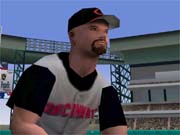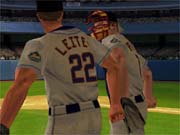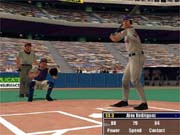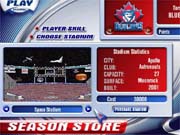It's very appropriate that the first words you hear when you begin playing Triple Play Baseball are, "That ball's outta here!" After all, it's the latest installment in an action-packed sports series that's always emphasized home-run excitement over meticulous stat crunching. And perhaps with good reason: America didn't go crazy over the national pastime in the summer of '98 because Greg Maddux led the Majors with a 2.22 ERA. Anyone who witnessed the media frenzy focused on the race to catch Roger Maris could hardly blame EA Sports for trying to cash in on the long-ball heroics of Mark McGwire and Sammy Sosa.

But you can blame EA Sports for taking this to an extreme. Offense has completely consumed the Triple Play Baseball series, to the point that the current edition isn't so much a computer representation of baseball as a rough simulation of hitting a ball with a stick. Every other aspect of the real sport has also been dumbed down to the point of irrelevance. Pitching, baserunning, fielding, and those all-important managerial moves mean nothing as long as you have good hand-eye coordination. Gameplay has devolved to a simple button-pushing exercise.
All of this would be at least partly excusable if playing the game itself were enjoyable. It isn't, and the main reason is overkill. Every Triple Play contest features a minimum of three dozen hits. This turns nine innings into an hour-long marathon that will try the patience of even the most dedicated player. Regardless of whether you're playing on the rookie, pro, or all-star difficulty settings, hits are so easy to come by that you'll rack up two or three per inning. Your final box score almost always reads like something out of a slo-pitch beer league. Home runs and hard shots to the gap are such routine events that they've been robbed of their natural drama and excitement.

Needless to say, this is the result of a thoroughly unrealistic pitching/batting model. The game turns the single most challenging action in sports into child's play. Hitting against computer pitching is ridiculously easy because you can get the end of your bat on anything this side of a pitchout. You can make solid contact on everything from balls thrown outside in the dirt to balls thrown inside at your head. Just time the swing right, and you're golden. This is simplified even more by the fact that computer pitchers refuse to "work" batters. Instead of trying to keep the hitter off-balance with a variety of pitch types, locations, and speeds, the computer-controlled hurler will often keep to the center of the plate. Swing early and often in Triple Play Baseball, and you can turn Rico Brogna into Ted Williams.
Pitching against the computer is similarly handicapped in that you can't fool your opponent into swinging at bad pitches. Switching speeds, mixing up fastballs and junk, and just generally moving the ball around are meaningless since the computer won't take the bait on pitches out of the strike zone (on difficulty levels above rookie). If you attempt to mess with the digital batter's mind the way that a flesh-and-blood pitcher would, you'll be rewarded by constantly falling behind in the count and then surrendering long singles or mammoth dingers into the bleachers. The only way to deal with this is by giving the computer exactly what it doesn't expect--grooved pitches in the middle of the plate at the start of every at bat. Our most successful games came as a result of simply gunning fastballs down the pipe for nine full innings.
Other problems contribute to making Triple Play Baseball such a tiresome experience. Extra base hits are nearly impossible to come by because every outfielder is equipped with racehorse legs and a cannon arm. Fielders can fire the ball around at real-life velocities that apparently approach 200mph, meaning that gappers to the wall remain singles. There's nothing quite as jarring for a baseball fan than to witness speedy Alex Rodriguez slap the ball 380 feet to left center and still be thrown out at second by five feet. The ball is thrown so fast in Triple Play Baseball that you can almost go around the horn on infield grounders and still get the runner at first. If nothing else, the game is very forgiving if you accidentally throw to the wrong base.

Computer-controlled first and third basemen often wander off their bags at key moments, killing sure double plays. This occasionally happens even if the fielder in question was part of the play originally. First basemen sometimes throw to second to get the lead runner and then walk well off the bag for the return toss, almost like they'd lost track of the number of outs. However, such glitches affect your fielding in turn, as the game often activates the wrong player (a second baseman on a ball hit near the shortstop, for example) to handle a ground ball. And last but not least, hits down the line still sporadically curve the wrong way. This holdover bug from previous Triple Plays continues to violate the laws of physics by curling balls in, rather than out.
What further heightens the sense of disappointment you'll have for Triple Play Baseball's gameplay is a full feature set indicating that it at least could have been the ultimate arcade baseball game. Triple Play Baseball is certainly the most comprehensive game in the history of this series, complete with all the bells and whistles demanded by arcade sports fans. Along with single-game, playoff, and season modes of play (including a multiseason franchise option), the big league challenge home-run derby is back with all 12 major-league participants. Season players who win the World Series go on to compete in a World Tournament featuring national all-star teams that can later be used in regular games. Points accumulated by racking up impressive season stats can be used to buy new fantasy home stadiums, including one on a beach and even one in space. Special rewards are unlocked in nearly every game, and this grants you humorous bonuses like "big head" or "big ball" play.

EA Sports didn't skimp on the production values. Player models look and move much like their real-world counterparts. Stars such as Randy Johnson, Nomar Garciaparra, and Kevin Brown have even had their signature moves fully motion captured. Scripted animations bring more of each game to life. Close-ups reveal player celebrations at the end of victories and arguments with umpires over close calls. The audio is similarly outstanding: You'll hear a variety of realistic ballpark sound effects from the crack of the bat to the shouts of hotdog vendors out in the stands. However, the play-by-play and color commentary isn't nearly as satisfying. Jim Hughson and Buck Martinez (presumably in his curtain call with the series, as he's now the manager of the Toronto Blue Jays) are back to fill the broadcast booth with more inanities than ever. Hughson is practically monosyllabic, and he'll go some innings saying little more than, "Fowwwulll!" when appropriate. Martinez's observations often have nothing to do with the play and are so generalized that players are referred to as, "That guy."
Still, attractive visuals and impressive features aren't enough to disguise that the core problem with Triple Play Baseball is that it's not about baseball. Any sense of Major League authenticity has been jettisoned because of the strange misconception in the design that those interested in buying such a game don't actually like the sport it represents. Furthermore, the designers have made these changes in such a ham-handed way that the meandering end result has been rendered nearly unplayable, especially for those who dislike baseball's deliberate pacing.